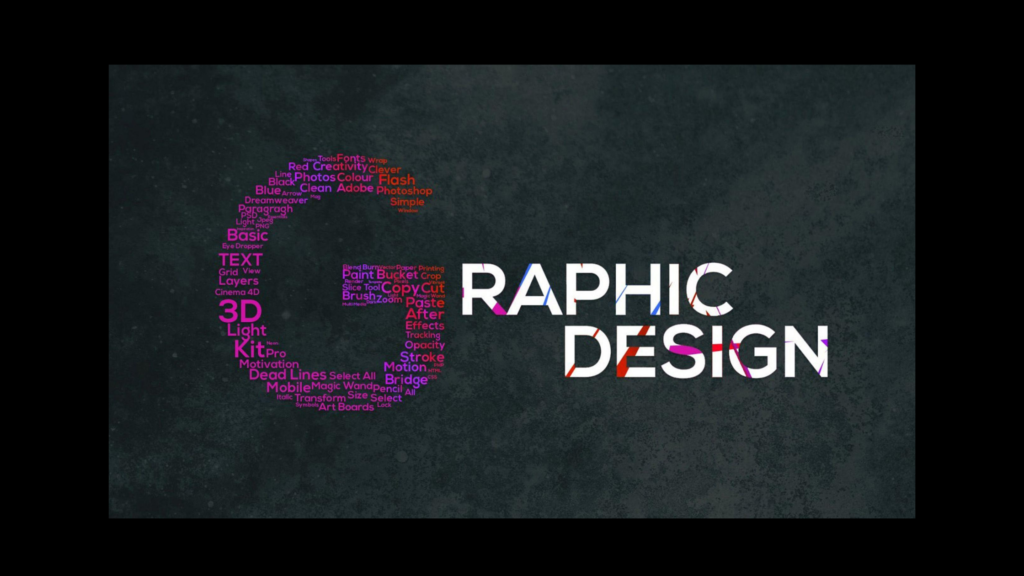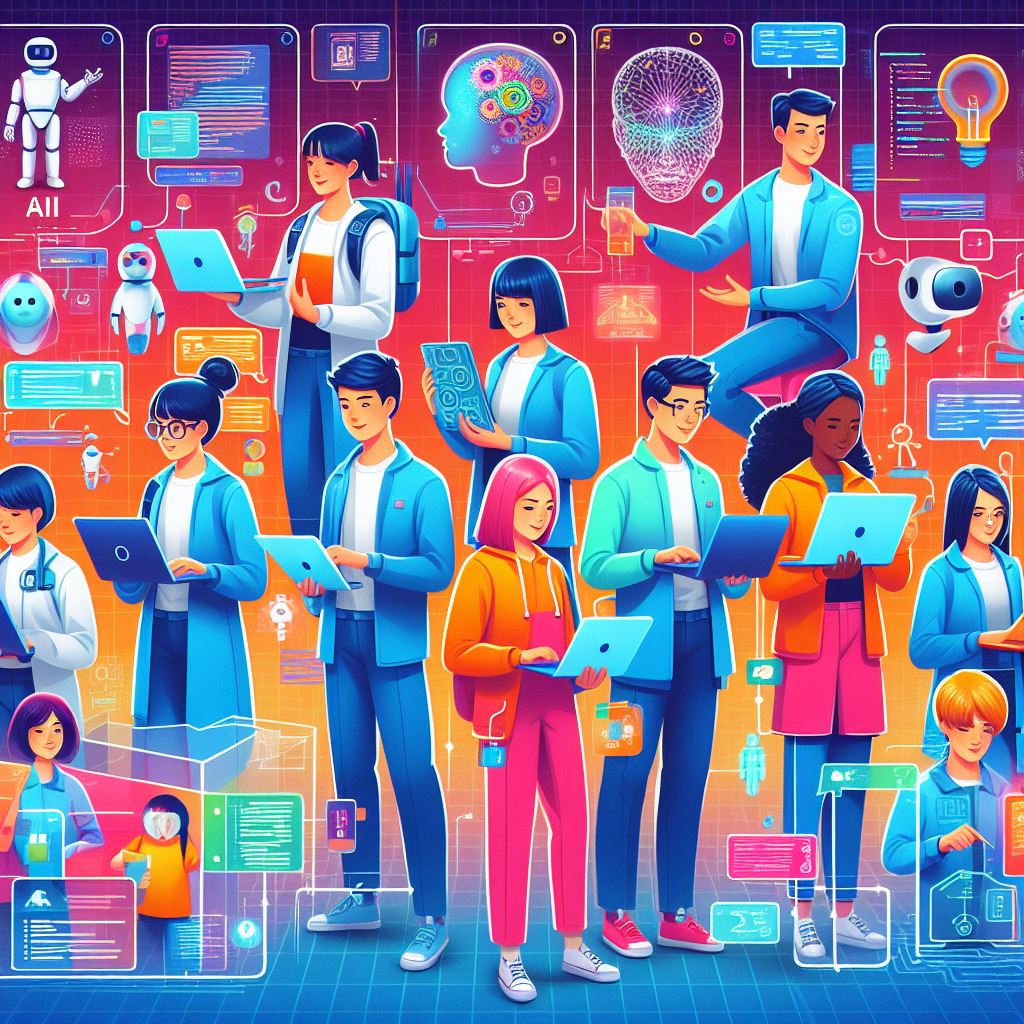Introduction and Overview
In a world where visual communication reigns supreme, Graphic Designer is the artistic linchpin that bridges imagination with reality. At its core, graphic design is crafting visual experiences that captivate, inform, and resonate. It’s the alchemy of typography, color, and form, transforming concepts into compelling visuals that speak louder than words.
From the logos emblazoned on your favorite products to the websites that seamlessly guide your digital adventures, graphic design is omnipresent, shaping perceptions and influencing decisions across industries. It’s the vital brushstroke that paints a brand’s identity, the meticulous layout that guides user interactions, and the innovative spark that breathes life into advertisements.
In a society where attention spans are fleeting, graphic design is the beacon that captures attention, conveys messages, and sparks connections. Its role in advertising, branding, web design, and beyond is undeniable, making graphic design a dynamic and indispensable career path for those who seek to transform creativity into impact.
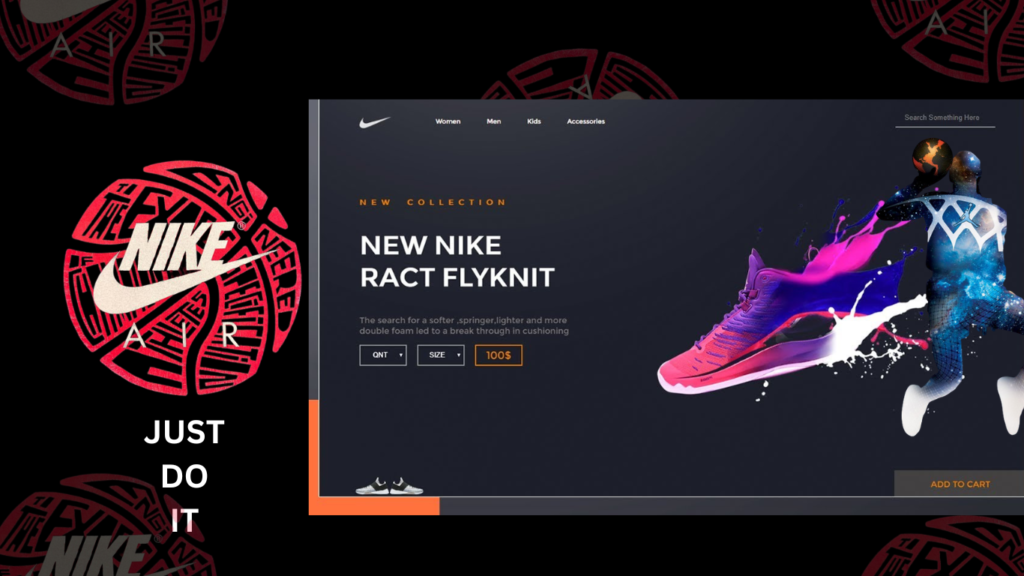
- Job Opportunities in Graphic Design
- Skills and Qualities for a Graphic Designer
- Educational Requirements and Training
- Explore Courses at Leading Universities
- Day in the Life of a Graphic Designer
- The Power of a Well-Structured Portfolio
- Harnessing Networking for Professional Growth
- Freelancing and Full-Time Paths
- Career Path for the Graphic Designer
- Challenges and Solutions
- External Link
- Conclusion
- Frequently Asked Questions
Job Opportunities in Graphic Design
Graphic Designers can find job opportunities in a wide range of industries where visual communication is essential. Here are some industries where graphic designers can expect to find employment:
- Advertising and Marketing: Graphic designers create eye-catching visuals for advertisements, promotional materials, and marketing campaigns. They work on print ads, digital banners, social media graphics, and more.
- Branding and Identity: Designers help businesses establish a cohesive visual identity by creating logos, brand guidelines, and packaging designs that convey the company’s values and personality.
- Web and Digital Design: In the age of technology, graphic designers craft engaging user interfaces (UI) and user experiences (UX) for websites, apps, and other digital platforms.
- Print and Publishing: Designers work for magazines, newspapers, publishing houses, and book publishers to design layouts, covers, and other printed materials.
- Entertainment and Media: From movie posters to album covers, graphic designers contribute to the visual appeal of the entertainment industry.
- Fashion and Apparel: Fashion brands require designers to create visually appealing advertisements, packaging, and even textile patterns.
- Gaming: Graphic designers design characters, environments, user interfaces, and marketing materials for video games.
- Architecture and Interior Design: Designers in this field create visual representations of architectural concepts, floor plans, and interior designs.
- Education: Educational institutions often employ graphic designers to create engaging educational materials, presentations, and visual aids for teaching.
- Healthcare and Pharmaceuticals: Graphic designers in this industry create medical illustrations, educational materials, and marketing collateral for pharmaceutical companies.
- Nonprofits and NGOs: Organizations working for a cause require designers for creating awareness campaigns, event materials, and fundraising visuals.
- Food and Beverage: Graphic designers create packaging, menus, labels, and promotional materials for food and beverage brands.
- Technology and Software: Tech companies need designers to create user interfaces, icons, and branding for their software products.
- Travel and Hospitality: Designers create visually appealing marketing materials for hotels, resorts, airlines, and travel agencies.
- Automotive and Transportation: From car advertisements to brochures, graphic designers contribute to the visual presentation of vehicles and transportation services.
- Real Estate: Designers create visuals for property listings, brochures, and marketing materials in the real estate sector.
These are just a few examples, and the demand for graphic designers continues to expand across various industries as businesses recognize the importance of visual communication in today’s competitive landscape.
Skills and Qualities for a Graphic Designer
Here’s a list of essential skills and qualities for a successful Graphic Designer:
- Diverse Skills and Qualities:
- Creativity is the core, of birthing innovative concepts.
- Mastery of design software like Adobe Creative Suite.
- Typography’s power in amplifying messages.
- Color theory’s role in evoking emotions.
- Attention to detail for exceptional creations.
- Effective communication for collaboration.
- Agility in adapting to evolving trends.
- Software Proficiency:
- Adobe Creative Suite as a designer’s toolkit.
- Typography and Color:
- Typography’s impact on messaging.
- Color theory’s emotional influence.
- Attention to Detail:
- Elevating creations through precision.
- Communication Skills:
- Bridging idea-to-execution gap.
- Fostering collaboration with clients.
- Adaptability and Trends:
- Agility in embracing evolving trends.
- Navigating Design Landscape:
- Skills and qualities as a compass for art, tech, and communication.

Designer Workspace
Educational Requirements and Training
The education path for a career in graphic design in India involves a combination of formal education, self-learning, and practical experience. Here’s a detailed breakdown of the steps:
1. High School Education: Begin with completing your high school education, typically up to 10th or 12th grade. It’s essential to have a strong foundation in subjects like art, design, and computer science.
2. Choose a Specialized Field: Decide whether you want to pursue a diploma, degree, or certification in graphic design. You can opt for various specializations such as visual communication, digital design, user experience (UX) design, or animation.
3. Pursue Formal Education: Options for formal education include:
- Diploma Courses: Several institutes offer diploma courses in graphic design that typically last 1-2 years. These programs provide a solid introduction to design principles, software tools, and hands-on projects.
- Bachelor’s Degree: Pursue a Bachelor’s degree in Graphic Design or related fields like Visual Communication, Fine Arts, or Applied Arts. These programs usually span 3-4 years and offer more comprehensive education, covering design theory, history, software proficiency, and portfolio development.
- Master’s Degree: Some universities offer Master’s programs in Graphic Design or related fields. These programs delve deeper into advanced design concepts, research, and specialization.
4. Self-Learning and Skill Development: In addition to formal education, continuously improve your skills through self-learning. Stay updated with the latest design trends, software updates, and emerging technologies. Online platforms like Udemy, Skillshare, Coursera, and LinkedIn Learning offer a plethora of design-related courses.
Explore Courses at Leading Universities
- National Institute of Design (NID), Ahmedabad
- Srishti Institute of Art, Design and Technology, Bangalore
- Pearl Academy, Delhi, Jaipur, Mumbai, Bangalore
- Symbiosis Institute of Design (SID), Pune
- Maharashtra Institute of Technology – Institute of Design (MITID), Pune
- Indian Institute of Technology Bombay (IIT Bombay), Mumbai
- Vellore Institute of Technology (VIT), Vellore
- Manipal Institute of Technology (MIT), Manipal
- Jain University, Bangalore
- For additional names visit below path https://www.shiksha.com/search?q=graphics%20design&rf=searchWidget
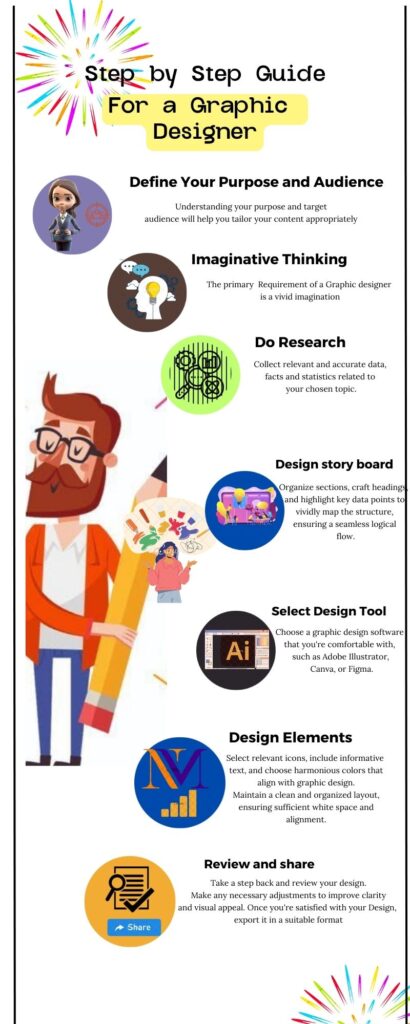
Step-by-step guide for a Graphic Designer
Day in the Life of a Graphic Designer
A day in the life of a graphic designer is dynamic and diverse, blending creativity, technology, communication, and problem-solving. Here’s a detailed breakdown of what their typical day might entail:
Morning:
- Start and Planning (9:00 AM): The day often begins with checking emails, organizing tasks, and reviewing the to-do list. Prioritizing projects and setting goals for the day is crucial.
- Creative Warm-Up (9:30 AM): Some designers engage in a creative exercise to get their creative juices flowing. This could involve sketching, doodling, or exploring design inspiration online.
- Project Work (10:00 AM – 12:00 PM): Dive into ongoing projects. This could involve designing logos, websites, marketing materials, or illustrations. Collaborate with team members or work independently, depending on the project.
Afternoon:
- Lunch and Break (12:00 PM – 1:00 PM): Take a break to recharge. Many designers use this time to step away from their desks, go for a walk, or engage in a hobby.
- Client Meetings (1:00 PM – 2:00 PM): If there are scheduled client meetings, discuss project updates, receive feedback, and clarify any doubts. Effective communication is key to understanding the client’s vision.
- Project Development (2:00 PM – 4:00 PM): Continue working on projects, refining designs, incorporating client feedback, and ensuring that the work aligns with the project’s goals.
Late Afternoon:
- Skill Enhancement (4:00 PM – 5:00 PM): Dedicate time to learn new design techniques, explore software updates, or take online courses to stay updated with industry trends.
- Administrative Tasks (5:00 PM – 5:30 PM): Wrap up loose ends, respond to emails, update project documentation, and organize files.
Evening:
- Review and Wrap-Up (5:30 PM – 6:00 PM): Review the day’s work, assess completed tasks, and ensure that everything is for the next day.
- Networking and Inspiration (6:00 PM – 7:00 PM): Engage in online design communities, follow design blogs, and seek inspiration for upcoming projects.
- Personal Projects (7:00 PM – 8:00 PM): Some designers work on personal projects to experiment with new ideas, styles, or techniques.
Night:
- Relaxation and Leisure (8:00 PM Onward): Wind down, spend time with family, engage in hobbies, or simply relax. A healthy work-life balance is essential for sustained creativity and well-being.
It’s important to note that the routine can vary based on the designer’s role, whether they’re freelancing or working in-house, and the specific projects they’re working on. Adaptability, creativity, and effective time management are key skills that allow graphic designers to navigate through their daily tasks and produce impactful designs.
The Power of a Well-Structured Portfolio
A robust portfolio is the graphic designer’s passport to professional success, encapsulating their journey, skills, and creative essence. It serves as a visual manifesto, speaking volumes about the designer’s capabilities.
Crafting a portfolio requires a strategic balance between variety and cohesion.
Showcase a diverse array of projects spanning different genres and mediums to exhibit versatility.
Displaying projects that mirror your passion and expertise enables potential clients and employers to grasp your unique artistic voice. Organize the portfolio thoughtfully, guiding viewers seamlessly through your work.
Each piece should be accompanied by concise explanations that unveil the design challenges, conceptual thinking, and solutions. High-quality visuals that capture the essence of each project are essential.
From logos to digital interfaces, every entry should reverberate with your personal style, leaving an indelible mark. A captivating portfolio not only showcases proficiency but also narrates your creative journey, magnetizing opportunities and paving the way for a fulfilling design career.
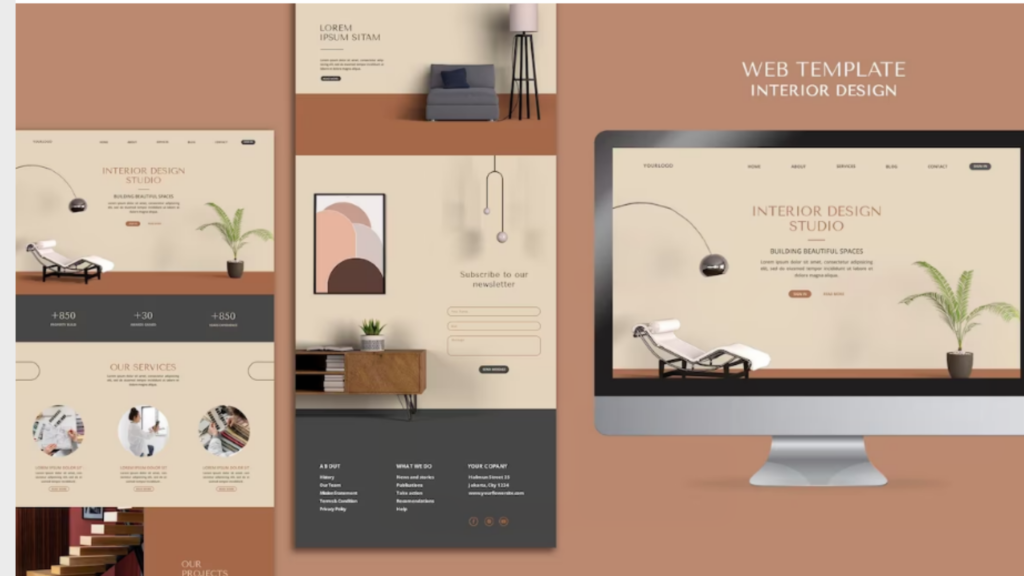
Mockup Portfolio for Website Interior Design
Harnessing Networking for Professional Growth
In the expansive realm of graphic design, networking isn’t just a choice – it’s a vital currency for growth. Embrace both virtual and physical avenues to weave connections that breathe life into your career.
Online platforms, like LinkedIn and design-focused forums, provide a digital nexus where ideas flow freely. Offline events, such as design conferences and workshops, offer a tactile meeting ground for forging relationships that transcend screens.
Professional organizations like AIGA and D&AD foster camaraderie, while granting access to exclusive resources and industry insights. Engaging in these gatherings unveils a world of opportunity, connecting you with fellow designers, potential clients, and employers.
The symphony of shared experiences not only enriches your knowledge but also fuels your creative spark. By weaving a tapestry of relationships, you pave the path towards an illustrious design journey, where collaboration and innovation dance hand in hand.

A group of designers engaging in a workshop
Freelancing and Full-Time Paths
The path of a graphic designer diverges into two distinct avenues: freelancing and full-time employment, each offering its own constellation of merits and considerations.
Freelancing unfurls the canvas of autonomy, where you sculpt your schedule and choose your projects. The freedom to chase diverse opportunities and tailor your work environment is intoxicating. However, with this independence comes the responsibility of managing your business, finding clients, and navigating financial fluctuations.
Conversely, full-time positions grant a stable harbor, with benefits, a predictable income, and the chance to immerse yourself in a team’s dynamics. Yet, this might tether your creative autonomy and limit the breadth of projects.
Ultimately, the decision hinges on your appetite for risk, your passion for self-direction, and your craving for creative collaboration. Whichever path you traverse, the graphic design landscape promises a voyage of discovery and impact.

Career Path for the Graphic Designer
The career path for a graphic designer typically involves several stages of growth and development. While the specifics can vary based on individual preferences and opportunities, here’s a general outline of the career path:
1. Entry-Level/Junior Designer: Starting as an entry-level or junior designer, you’ll work on basic design tasks and support more experienced designers. You’ll learn to use design software, develop a keen eye for design aesthetics, and gain an understanding of design principles.
2. Mid-Level Designer: As a mid-level designer, you’ll take on more complex projects and have a greater role in the creative process. You might work on larger design projects, collaborate with clients, and begin developing your own design style and voice.
3. Senior Designer: At the senior level, you’ll have accumulated significant experience and a strong portfolio. You’ll take on leadership roles, guide junior designers, and contribute to strategic decisions in design projects. Your expertise will be recognized, and you might specialize in a specific area of design.
4. Art Director/Creative Director: Moving into roles like Art Director or Creative Director, you’ll oversee entire design projects, manage teams of designers, and provide creative direction. You’ll be responsible for setting the overall artistic vision and ensuring design consistency across various projects.
5. Freelancer/Independent Designer: Some designers choose to become freelancers or independent designers at various stages of their careers. This offers greater flexibility, the chance to work on diverse projects, and the potential to manage your own clients and workload.
6. Specialization: As you gain experience, you might choose to specialize in a specific niche of graphic design, such as web design, UX/UI design, motion graphics, branding, packaging, or illustration. Specializing can open up new opportunities and allow you to become an expert in your chosen area.
7. Design Management or Teaching: For those interested in a managerial role, you could move into design management, overseeing multiple design projects and teams. Alternatively, you might transition to teaching design at educational institutions to share your knowledge and mentor the next generation of designers.
8. Entrepreneurship: Some experienced designers with an entrepreneurial spirit might start their own design agencies or studios, offering a range of design services to clients and managing a team of designers.
Throughout your career, continuous learning, staying updated with design trends and technology, building a strong network, and updating your portfolio will be crucial to your growth and success as a graphic designer.
Challenges and Solutions
Handling Client Feedback: Scenario: Client feedback can be overwhelming and conflicting, derailing the design process. Solution: Approach feedback with an open mind. Seek clarification, understand their vision, and offer your insights. Collaborate to find a middle ground that aligns with both the client’s goals and your design expertise.
Managing Creative Blocks: Scenario: Staring at a blank canvas, ideas seem elusive, and inspiration is at a standstill. Solution: Step away and engage in unrelated activities to refresh your mind. Experiment with new mediums or brainstorm with peers. Embrace constraints and set limitations to spark unconventional creativity.
Dealing with Tight Deadlines: Scenario: A project with an imminent deadline requires quality work under time pressure. Solution: Break the project into stages with mini deadlines. Prioritize tasks and create a detailed schedule. Communicate with clients about realistic timelines, renegotiating if needed.
Balancing External Pressure: Scenario: Juggling multiple projects while maintaining quality amid external demands. Solution: Set clear expectations with clients upfront. Learn to say no when overwhelmed. Practice self-care and establish boundaries to avoid burnout.

Project Deadlines
External Link
skillshare – https://www.skillshare.com/en/browse/graphic-design
Youtube Videos
Conclusion
The future for graphic designers is an exciting canvas waiting to be painted with innovation and imagination. As technology continues to evolve, the role of graphic designers will transcend conventional boundaries, embracing a fusion of artistry and technology.
Visual communication will be pivotal in shaping our digital world, with designers at the forefront of crafting captivating narratives that resonate across platforms.
Augmented reality (AR) and virtual reality (VR) will blur the lines between the tangible and the digital, offering immersive experiences that demand a new level of creativity. Think of interactive packaging that reveals stories, or spatial designs that transcend screens.
Artificial intelligence (AI) will become a collaborator, automating repetitive tasks and offering insights, liberating designers to focus on their most imaginative work.
Sustainability will take centre stage, compelling designers to infuse eco-consciousness into every pixel. Just as designers today couldn’t have predicted the digital revolution, the future holds equally transformative possibilities. The journey ahead is a tapestry woven with pixels, imagination, and the power to reshape our world one design at a time.
Here is the link for other career paths https://futurereadytools.com/category/careers/
Frequently Asked Questions
1. Q: What is a Graphics Design career path?
A: A graphics design career path refers to the journey an individual takes in pursuing a profession within the field of graphic design. It involves developing visual content for various mediums such as print, digital media, advertising, branding, and more.
2. Q. How do I become a Graphics Designer?
A: To become a graphics designer, you typically need a combination of formal education (such as a degree in graphic design or a related field), a strong portfolio showcasing your work, and proficiency in design software like Adobe Creative Suite. Internships, workshops, and continuous self-learning are also valuable.
3. Q: What skills are important for a Graphics Design career?
A: Important skills for a graphics design career include creativity, proficiency in design software (e.g., Photoshop, Illustrator), a strong sense of aesthetics, typography skills, understanding of color theory, ability to work within design guidelines, communication skills, and adaptability to industry trends.
4. Q: What job roles can I pursue in Graphics Design?
A: Graphics design offers various job roles including graphic designer, web designer, UI/UX designer, motion graphics designer, art director, brand identity designer, packaging designer, and more. These roles cater to different aspects of visual communication.
5. Q: Is a degree necessary for a career in Graphics Design?
A: While a degree can provide a solid foundation, it’s not always necessary. Many successful designers have entered the field with self-taught skills and a strong portfolio. However, formal education can offer structured learning, networking opportunities, and credibility.
6. Q: How important is building a portfolio in Graphics Design?
A: Building a strong portfolio is crucial in graphics design. It showcases your skills, style, and versatility to potential clients or employers. A well-curated portfolio demonstrates your ability to tackle a range of design challenges and gives insight into your creative process.
7. Q: What industries require Graphics Design services?
A: Graphics design is needed across various industries, including advertising, marketing, publishing, entertainment, fashion, tech, and more. Virtually any business or organization that seeks to communicate visually with its audience requires graphics design services.
8. Q: What is the earning potential in Graphics Design?
A: Earning potential in graphics design varies based on factors like experience, location, specialization, and the size of the company you work for. Junior designers might start with lower salaries, but as you gain experience and reputation, your earning potential increases.
9. Q: How do I stay updated with the latest design trends?
A: Staying updated with design trends involves continuous learning. Follow design blogs, attend design conferences, engage with design communities on social media, and subscribe to industry newsletters. Platforms like Behance and Dribble showcase current design work.
10. Q: How can I advance in my Graphics Design career?
A: To advance in your graphics design career, focus on refining your skills, expanding your portfolio, networking with professionals, seeking mentorship, considering specialization (e.g., UI/UX, branding), and taking on challenging projects to showcase your growth and capabilities.
Remember that a career in graphics design requires dedication, continuous learning, and a passion for creativity. It’s a dynamic field that rewards those who are willing to evolve with changing technologies and design trends.

